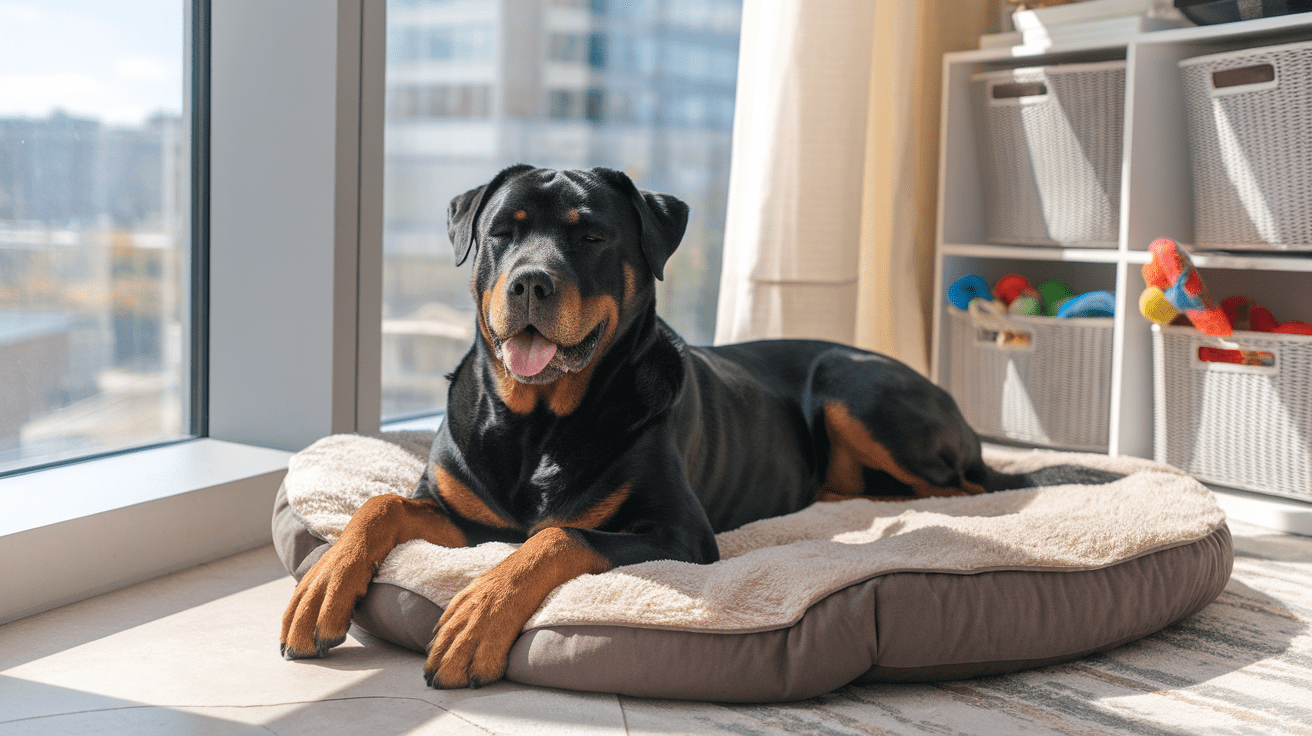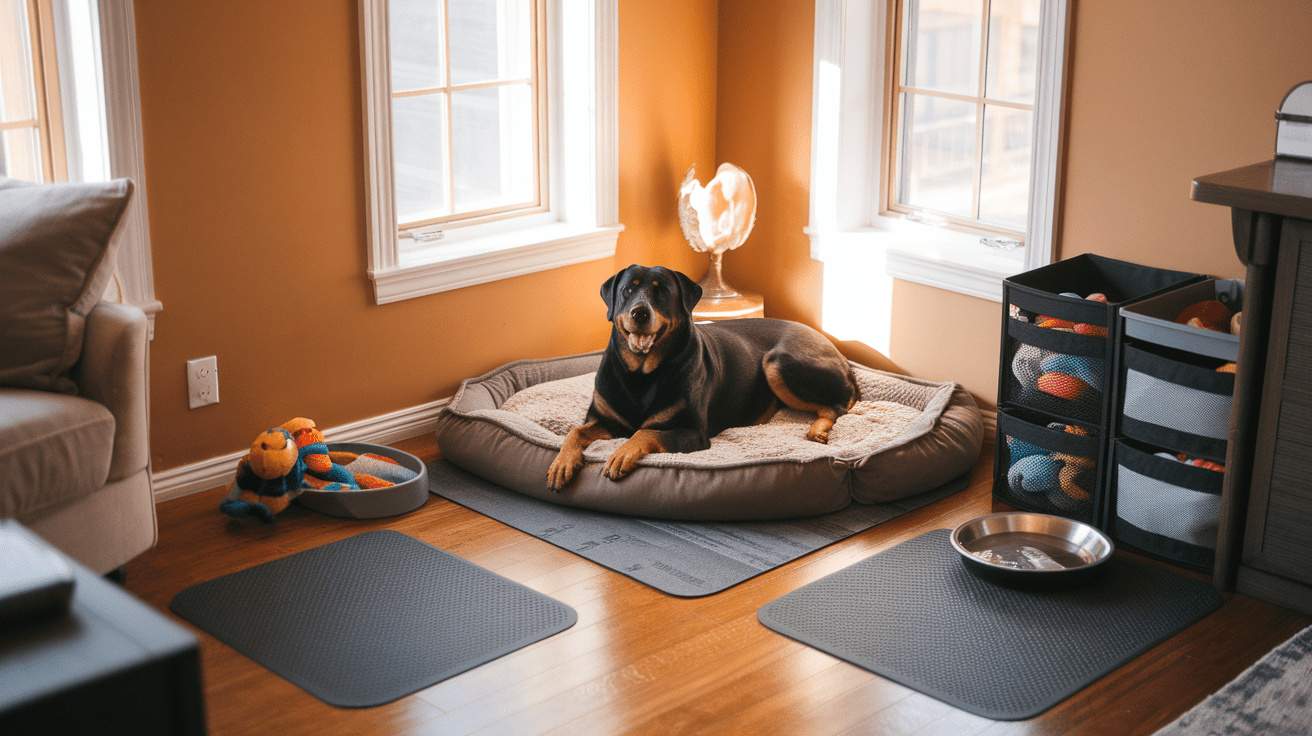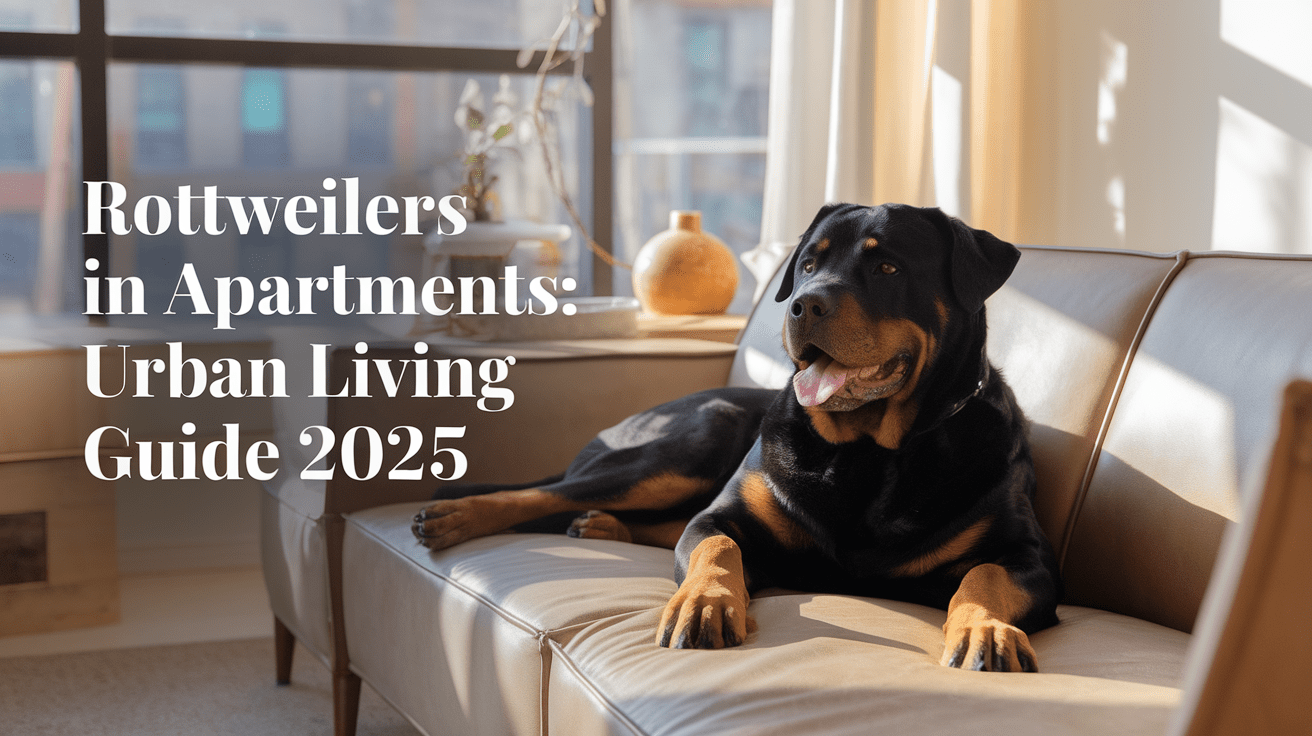Can Rottweilers Live in Apartments Key Takeaways
- ✓ Space Requirements: Rottweilers can adapt well to apartment living, as quality of activity matters more than quantity of space.
- ✓ Exercise Needs: 1-2 hours of daily exercise and mental stimulation are essential for a happy apartment Rottweiler.
- ✓ Proper Planning: Success depends on creating designated areas for rest, play, and feeding, plus maintaining positive neighbor relations.
- ✓ Training Focus: Consistent training and socialization are crucial for developing a well-behaved apartment dog.
- ✓ Owner Commitment: Success in apartment living depends more on the owner’s dedication than the size of living space.
Can Rottweilers live in apartments? Yes, they can – but it requires dedication and proper planning. As a veterinarian and Rottie owner living in a Manhattan apartment, I’ve experienced firsthand that these powerful pups can thrive in urban spaces. According to the American Kennel Club, 45% of large-breed dogs successfully adapt to apartment living when their exercise and mental stimulation needs are met.
Despite their impressive size and reputation as working dogs, Rottweilers are surprisingly adaptable and can be excellent apartment companions. What matters most isn’t the size of your living space but rather your commitment to meeting their needs. Think of them as gentle giants who’d rather lounge on your couch after a good workout than patrol a huge backyard all day.
In this comprehensive guide, we’ll explore everything you need to know about raising a happy, healthy Rottweiler in an apartment, from space management to exercise solutions and neighbor relations.
Understanding Rottweilers’ Space Requirements

As a veterinarian who’s raised Rottweilers in various living situations, I can tell you that these dogs’ space requirements are often misunderstood. While Rottweilers originated as working dogs in the German town of Rottweil, they’ve evolved to become incredibly adaptable companions. According to a study by the American Veterinary Medical Association, large dogs can actually be less active indoors than many smaller breeds.
Let me share a quick story about my Rottie, Max. Despite living in my 800-square-foot apartment, he spends most of his day lounging on his favorite spot on the couch. What’s crucial isn’t the square footage – it’s how you utilize the space.
Natural Habitat and Living Conditions
Contrary to popular belief, Rottweilers don’t need vast spaces to be happy. Their ancestral role as cattle drivers and cart pullers meant they were accustomed to:
• Working in close proximity to humans
• Following specific routines
• Adapting to different environments
Physical Exercise vs. Living Space
The key to a happy apartment Rottweiler is understanding that quality of activity matters more than quantity of space. These intelligent dogs need:
• 1-2 hours of daily exercise
• Mental stimulation through training and play
• Structured activities rather than aimless yard time
Impact of Apartment Size
While there’s no minimum square footage requirement for Rottweilers, consider these factors:
• Clear pathways for movement
• Space for a large dog bed
• Room for food and water stations
• Area for interactive play
Think of your apartment like a cozy den – Rottweilers don’t need a mansion, they need a well-organized space that meets their basic needs. The success of apartment living with a Rottweiler depends more on your commitment to exercise and enrichment than the size of your living room.
Making Apartment Living Work for Your Rottweiler

Having helped countless urban Rottweiler owners through my veterinary practice, I’ve developed proven strategies for successful apartment living. According to a recent survey by Apartments.com, 72% of apartment-dwelling dog owners report their pets adapt well when proper accommodations are made.
The secret lies in creating a structured environment that caters to your Rottweiler’s physical and emotional needs. Think of your apartment as a cozy den that needs three essential elements: rest, play, and training areas.
Essential Indoor Accommodations
Creating a comfortable living space for your Rottie requires thoughtful planning. In my apartment, I’ve designated specific zones that help maintain order and comfort:
• A quiet corner with an orthopedic bed for resting
• A designated feeding area away from high-traffic spots
• A toy storage zone accessible to your dog
• Non-slip mats on slippery floors
I remember when my Rottie, Max, first moved in – we learned quickly that strategic placement of his items made a huge difference in his adjustment period.
Exercise and Activity Solutions
Living in an apartment doesn’t mean compromising on exercise. Your Rottweiler needs:
• Two 30-minute walks daily at minimum
• Interactive play sessions with puzzle toys
• Training exercises that combine mental and physical stimulation
During bad weather, I engage Max in indoor activities like:
• Hide-and-seek with treats
• Tug-of-war games
• Basic obedience training
• Stair exercises (if available)
Managing Neighbor Relations
Positive relationships with neighbors are crucial for apartment living success. Here’s what works:
• Introduce your Rottweiler to neighbors gradually
• Use positive reinforcement for quiet behavior
• Schedule walks during less busy hours
• Keep updated vaccination records handy for building management
Remember, a well-trained Rottweiler is a welcome neighbor. Focus on basic commands like “quiet,” “wait,” and “leave it.” These skills are invaluable in close-quarters living. Being proactive about training and socialization will help ensure your Rottie becomes a model apartment resident.
Pros and Cons of Keeping a Rottweiler in an Apartment

After treating hundreds of apartment-dwelling Rottweilers and living with my own, I’ve observed clear advantages and challenges. According to a recent study by ApartmentGuide, 65% of urban dog owners report stronger bonds with their pets due to closer living quarters.
Advantages of Apartment Living
Living in close quarters with your Rottweiler can offer surprising benefits:
• Increased bonding opportunities through constant interaction
• Better monitoring of health and behavior changes
• More structured routine and consistent training
• Protected environment from extreme weather
I’ve noticed that my apartment Rottie, Max, is more attuned to my daily routine than my previous dogs who lived in houses with yards. This close connection makes training and communication notably easier.
Common Challenges and Solutions
Being honest about challenges helps prepare for success. Common issues include:
• Limited immediate access to outdoor spaces
• Potential noise concerns with neighbors
• Space constraints for multiple pets
• Building restrictions and regulations
However, these challenges have straightforward solutions:
• Establish a consistent walking schedule
• Invest in sound absorption materials
• Create efficient storage solutions
• Research pet-friendly buildings before moving
Success Stories and Real-Life Examples
One of my clients, Sarah, lives in a 600-square-foot studio with her Rottweiler, Bear. She transformed potential limitations into advantages by:
• Converting her morning commute into walking time
• Using lunch breaks for training sessions
• Participating in weekend agility classes
• Building a community of dog-loving neighbors
Final Verdict on Apartment Suitability
Rottweilers can absolutely thrive in apartments when their needs are met. Think of it like this: just as humans can be happy in various living spaces, dogs adapt to their environment when their physical and emotional needs are fulfilled. The key isn’t the size of your space – it’s your commitment to providing:
• Regular exercise
• Mental stimulation
• Consistent training
• Loving attention
Remember, a well-exercised Rottweiler will be calm and content in any living situation. Success depends more on the owner’s dedication than the square footage of their home. With proper planning and commitment, your apartment can become the perfect den for your Rottie companion.
Frequently Asked Questions About Rottweilers Living in Apartments
Conclusion
Living with a Rottweiler in an apartment is not just possible – it can be a rewarding experience for both you and your dog. The key to success lies in understanding that these intelligent and adaptable dogs don’t measure their happiness by square footage, but by the quality of care and attention they receive. With proper planning, consistent exercise, and dedicated training, your Rottweiler can become an exemplary apartment resident.
Remember that a happy Rottweiler is one whose physical and mental needs are met, regardless of living space. Focus on creating a structured routine, maintaining positive relationships with neighbors, and providing adequate exercise. If you’re willing to commit to these essential elements, your Rottweiler can absolutely thrive in apartment living. It’s not about where you live – it’s about how you live together.
As a veterinarian, I can’t stress enough the importance of understanding your Rottweiler’s health needs, especially in apartment settings where early detection of issues is crucial. For a comprehensive overview of health considerations, check out our detailed Rottweiler Health 101 Guide, which covers everything from common breed-specific issues to preventative care measures that every Rottie owner should know. Regular health monitoring and preventative care are essential components of responsible apartment living with your Rottweiler.







